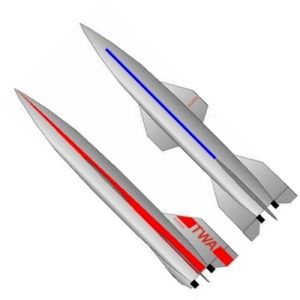
Home - Search - Browse - Alphabetic Index: 0- 1- 2- 3- 4- 5- 6- 7- 8- 9
A- B- C- D- E- F- G- H- I- J- K- L- M- N- O- P- Q- R- S- T- U- V- W- X- Y- Z
Tsien Spaceplane 1949
 Tsien's Rocketplane Tsien Hseu-Shen's 10 passenger transcontinental rocket transport, 1949. Credit: © Mark Wade |
Status: Design 1949. Payload: 2,000 kg (4,400 lb). Gross mass: 44,000 kg (97,000 lb). Height: 24.05 m (78.90 ft). Diameter: 4.88 m (16.01 ft). Span: 5.76 m (18.89 ft).
He proposed a 5,000 km-range single stage winged rocket clearly derived from V-2 aerodynamics. The 22,000 kg rocket would carry ten passengers from New York to Los Angeles in 45 minutes. It would take off vertically, with the rocket burning out after 60 seconds at 14,740 kph at 160 km altitude. After a coast to 500 km, it would re-enter the atmosphere and enter a long glide at 43 km altitude. Landing speed was to be 240 kph. Tsien's fundamental theoretical work on this concept lead to him being called the ‘Father of the Dyna-soar' (a 1950's/1960's delta winged spaceplane that was the ancestor of the space shuttle). The Mach 12 glider would have to use exotic high-performance LF2/LH2 propellants to achieve the designed performance.
Payload: 2,000 kg (4,400 lb) to a 5000 km gliding range.
Family: Chinese Manned Spacecraft, Rocketplane, Spaceplane, Suborbital, Winged. People: Tsien. Country: USA. Bibliography: 47, 49.
1949 During the Year - .
- Tsien Passenger Spaceplane - . Nation: China. Related Persons: Tsien. Class: Manned. Type: Manned spaceplane. Spacecraft: Tsien Spaceplane 1949. Tsien Hsue-shen proposed a 22,000 kg single stage winged rocket that would carry ten passengers from New York to Los Angeles in 45 minutes..
Back to top of page
Home - Search - Browse - Alphabetic Index: 0- 1- 2- 3- 4- 5- 6- 7- 8- 9
A- B- C- D- E- F- G- H- I- J- K- L- M- N- O- P- Q- R- S- T- U- V- W- X- Y- Z
© 1997-2019 Mark Wade - Contact
© / Conditions for Use